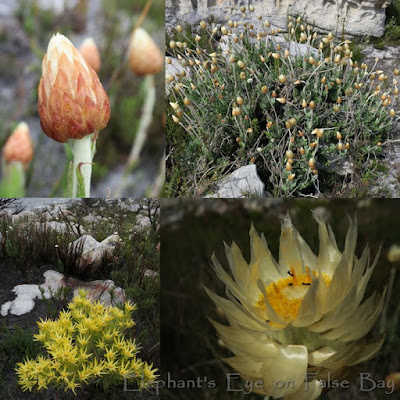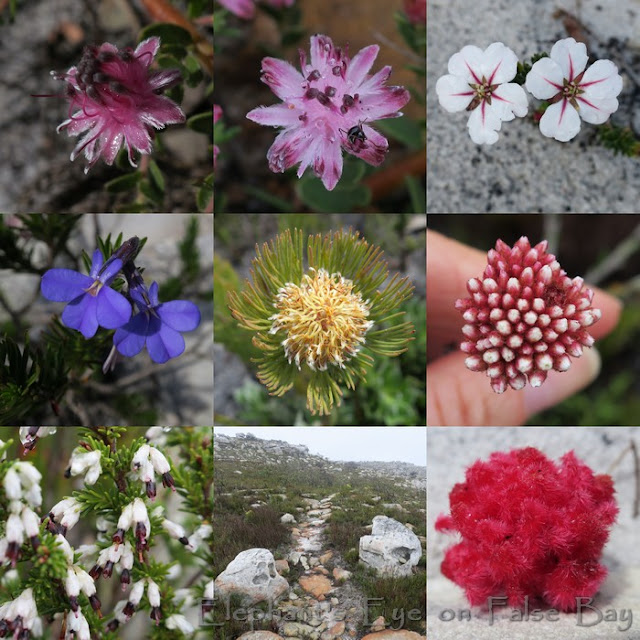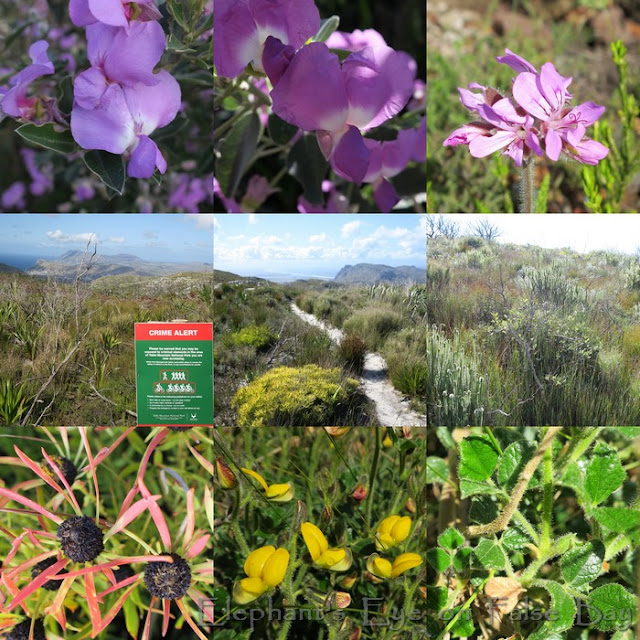From the Sentinel to Redhill
by Diana
Studer
- gardening for biodiversity
in Cape Town, South Africa
Hiking among wildflowers
in the mountains
around Cape Town
In August the Ungardener scrambled up Steenberg Buttress to
Lower Steenberg Peak all the way up 504 metres from sea level. Tuesday rain
dancers kindly bringing us some rain most weeks.
My fynbos ramble went to Cape
Point where the everlasting daisies were tight buds. A fortnight later Syncarpha speciosissima flowers were
open at Redhill. The landscape dotted with sunshine bushes Leucadendron salignum in spring golden leaves.
Tiniest of the proteas (zoom in to see the ant for scale) is
Diastella
divaricata. China flower Adenandra
villosa gleaming like delicately glazed porcelain. Vibrant blue of Lobelia pinifolia. You know the blushing
bride protea, demure in pink and white? This is her feisty fiery sister in
glowing golds. Serruria villosa endemic
to the Cape Peninsula. Cerise buds open to white flowers on Anaxeton laeve. Salt and pepper is Erica imbricata. Parasite on roots in
red velvet is Hyobanche.
In September he hiked from the East Fort to the manganese
mine. Looking across to the Sentinel.
We went up Noordhoek
Peak (a gentler circuit than his). Grateful for many eyes or we would have
missed this orchid moment. On the sunny side Pterygodium catholicum
its hooded head bowed down. On the damp and shady side Satyrium odorum (rising from the promising leaves on earlier
walks).
Sweetpea bushes Podalyria
calyptrata in a gentle range of pinky mauves with silver leaves (love that
but can't keep them alive!) Pelargonium
capitatum echoes the pink. A pointed reminder of why we are walking in a
group. Leucadendron salignum has
weird cone flowers. Bolusafra bituminosa
is another in the pea family but with tar scented oil glands on its leaves.
They climbed, with ropes, up the Sentinel in Hout Bay. 331
metres sheer down to the sea. A bird's eye view of Seal Island. Smoke rising
from unrest in Hout Bay which they were escorted thru once they were down
again.
Thanks to one of our botanical ladies, who also does the
mountain climbs, for an Erica halicacaba. Grows on
cliffs and named for the Cape gooseberry (from Peru but the fruit grows in our
garden) No way I could perch on a cliff to see this growing.
Last week we headed towards Simon's Town, Red Hill and
Maylands. Understated notes on our map remind me of Highland Clearance in
Scotland, as these farms and villages were obliterated but for names on the map
during apartheid.
Large and striking yellow daisies are insultingly called
Cape Weed Arctotheca calendula. Monkey
beetle on buttons of Cotula orbiculata.
Yellow stars of Pauridia capensis
(was Spiloxene). Tripteris clandestina with flat shiny flakes of seed. Tiniest bunch
of roses is Petalacte coronata with
silver leaves (another for my wish list). A taller prouder cousin to the rain
daisy is Dimorphotheca nudicaulis.
Delicate spikes of understated mauve on Cyphia
bulbosa. Striped and spotted petals on Tritoniopsis
dodii. Tall purple Senecio arenarius.
Babiana ambigua has peacock eyes at
the heart of its throat. Mimetes and Leucadendron cover the slope. Glowing in
peach Oxalis obtusa.
As we drove up there were hundreds of these glowing golden
orange spikes beside the road. I thought Bulbine? But it is Satyrium coriifolium. Spectacular!
I invite you to join us at Elephant's Eye on False Bay.
Please subscribe as you prefer
via Feedly,
or Bloglovin,
Teal blue text is my links.
To read comments if you are in email or a Reader,
first click
thru to the blog)
Thanks for comments that add value. Maybe start a new thread
of discussion? BTW your comment won't appear until I've read it. No Google
account? Just use Anonymous, but do leave a link to your own blog. I would
return the visit, if I could...
I welcome comments on posts from the last 2 months.
Danke für
sinnvolle Kommentare. Die werden erst veröffentlicht nachdem ich sie gelesen
habe. Es können auch Bemerkungen sein die in eine ganz andere Richtung gehen.











Such amazing plants to be enjoyed on your hikes and climbs. Well worth the effort for plant lovers. Happy you are getting rain!
ReplyDeleteCounting every single millimetre! 4 next Monday??
DeleteNow that is quite a climb but what a view. Your wildflowers always take my breath away...some so small and so stunning....love that orchid find too. What a beautiful plant growing off the cliff.....I couldn't climb out there either to see it grow.
ReplyDeleteMany are so tiny that it is only back on my laptop screen that I can see the joy!
DeleteAll I seem to do is sigh over the many wonderful plants growing in your region. I'd never even thought of visiting South Africa before I started following your blog but now it seems like something I should plan!
ReplyDeleteSuccess ;~)
DeleteIt's so fascinating to see your wildflowers--they're so different from ours, and most are unfamiliar, though fabulous. It's fascinating to learn about them. What wonderful places you have nearby for hiking! That view out over the Sentinel at East Fort is incredibly beautiful!
ReplyDeleteToday I have a fresh haul.
DeleteGoodness! What a collection of incredible flowers all so bright and happy and some so tiny. Love that landscape what a joy xxxc
ReplyDeleteYou would enjoy it too - and we have summer hot sun already.
DeleteAll those colorful flowers ... so strange, so beautiful. That Hyobanche looks alien.
ReplyDeleteThat is the tip of the bud emerging. Once the spike rises and the flowers open it loses its weird.
DeleteYour wild flowers are lovely ... Some so delicate and tiny ... You wonder how they survive the wind & weather on the mountains. My mother loved the Cape gooseberry bush I'm sure she would have been surprised to see it growing on the cliff face like that..
ReplyDeleteIt is called the gooseberry erica for the flower shape and colour, but the fruit grows down here in our gardens.
DeleteI always enjoy your posts on Wildflower Wednesday. Everything is so different from anything I have. Thank you for taking the time to share.
DeleteJeannie @ GetMeToTheCountry.Blogspot.com
So many wildflowers, and I adore the rugged scenery. What a wonderful place to live.
ReplyDelete